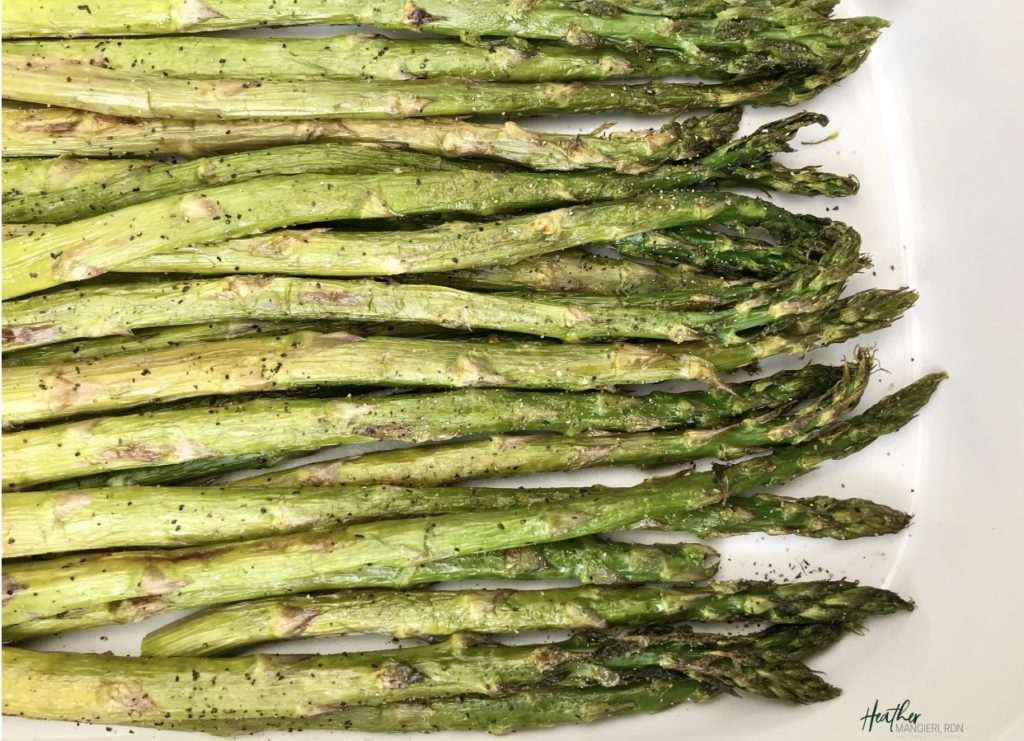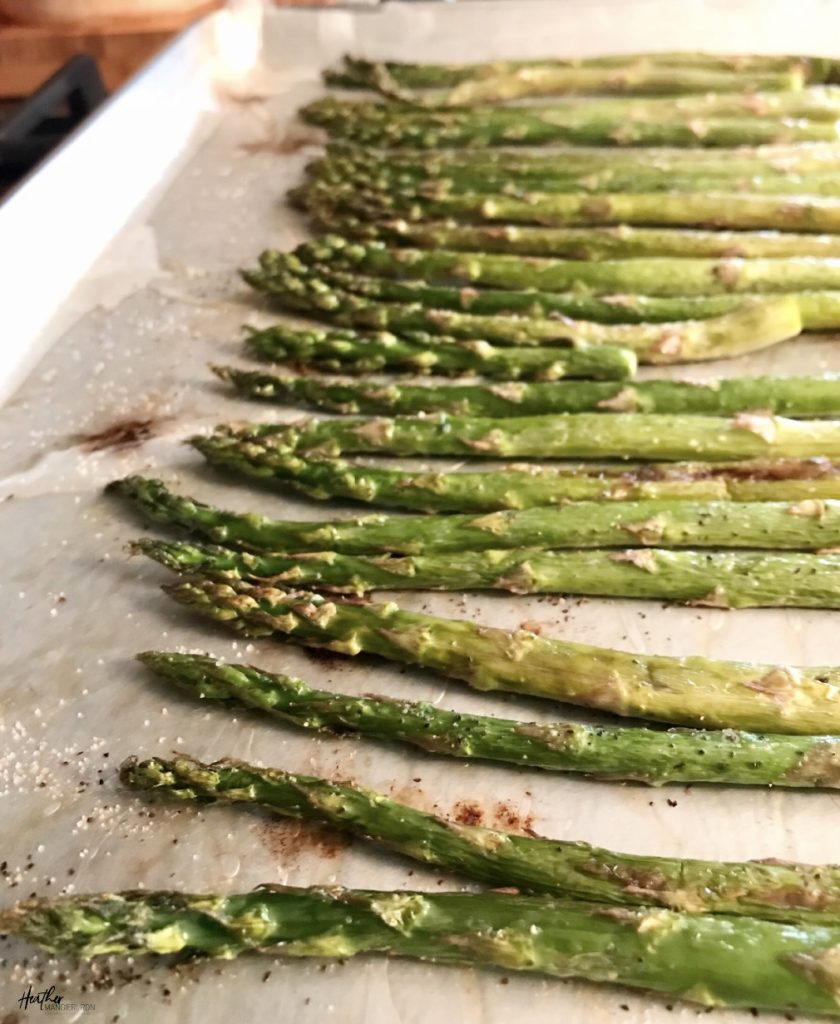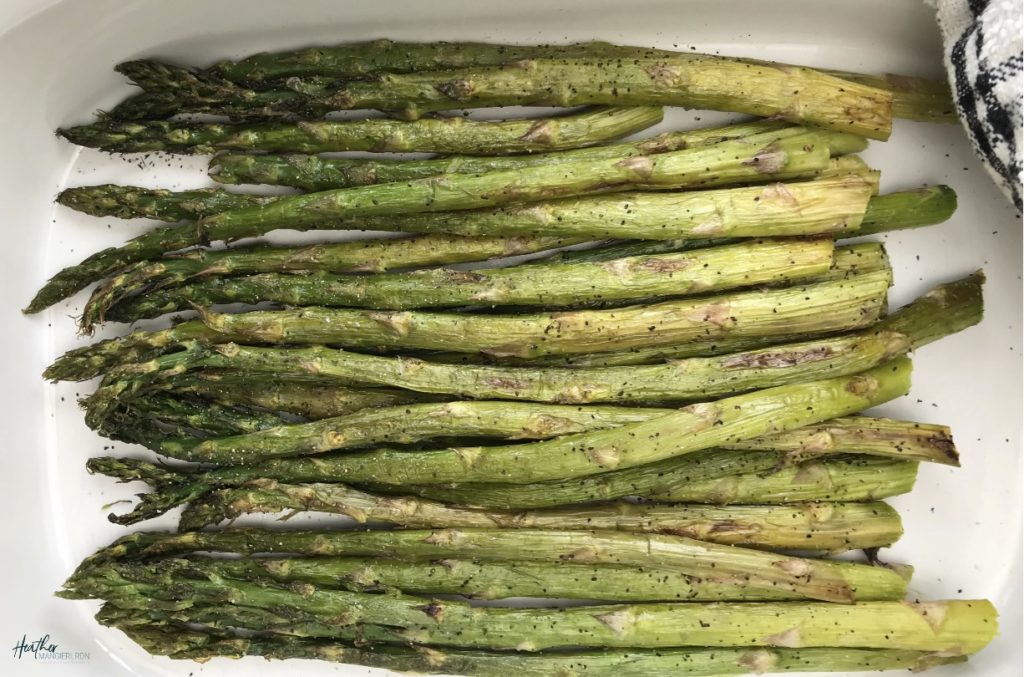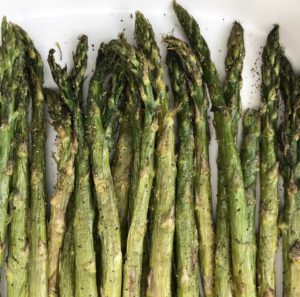This oven-roasted asparagus is absolutely delicious and super simple to prepare. It pairs well with most proteins, or can be chopped and added to salads, pizza, pasta, frittatas and more.

It’s asparagus season, so what better time than now to talk about this nutritious vegetable and share my favorite way to prepare it – oven-roasted with olive oil, salt and pepper. If you are here just for the recipe, you can scroll down and print the recipe card below. The dietitian in me has to share some of the nutrient benefits with you. I also explain how to select and store asparagus, so you get the most out of this nutrient-rich veggie.
How To Make Roasted Asparagus
It doesn’t matter what vegetable it is, if it’s roasted, I love it. Probably because I hate soggy food, and roasting gives vegetables a nice crispy coating. Plus, roasting is easy. The key to perfectly roasted asparagus is choosing spears that are all similar in size. That way, they cook at the same rate.
Roasted asparagus cooks at a high temperature, so start by preheating your oven to 425 degrees Fahrenheit. Line a baking sheet with foil or Parchment paper, and spray it with cooking spray.
Make sure to clean and trim the asparagus first. I generally cut ~1/2- 1 inch off the end. Once the asparagus is trimmed, place the spears in a medium sized bowl.

Drizzle olive oil over the asparagus. You only need a small amount to get a nice crispy coating on the outside, so don’t overdo it. One tablespoon is plenty to coat the 24 spears I made for this recipe. Be sure to massage the oil over each spear, as evenly as possible.
Place the asparagus in a single layer on the baking sheet, then sprinkle with a small amount of salt and pepper.
The cooking time will vary based on the thickness of the asparagus spears. Medium to large spears, with an average thickness, will bake for ~12-15 minutes. I suggest checking the asparagus after 12 minutes. If it needs more time, put it back in the oven for another few minutes. Just be sure to keep an eye on it, so you don’t overcook it.

Asparagus Season and Picking Fresh Asparagus
Asparagus is grown in a few US states, but a large percentage of asparagus sold in the United States is imported from Central and South America. Most of the asparagus harvested in the US is sold fresh, not frozen or canned. Three primary states – California, Washington and Michigan – are responsible for US commercial asparagus production.
I’ve never visited an asparagus farm, but I’ve been trying to make it to the National Asparagus Festival for the past five years. I always seem to have something planned during the dates of the event. This year, I was determined. I had a trip planned to Oceana County, Michigan in June. This was the year! That is, until the coronavirus pandemic hit. The 2020 festival was cancelled due to COVID-19 concerns. Unfortunately, my trip has been postponed for another year. At least I can still eat asparagus!
Selecting and Storing Asparagus
Asparagus is available year round at the super market, and is sold in bundles. When selecting your asparagus, look for stalks that are firm and straight with dry, tight tips. Wilted or limp stems can be a sign of old age. You should also smell the asparagus prior to selecting. Fresh asparagus is odorless, so if you detect a bad odor, it’s best to avoid it.
It can be refrigerated for up to 4 days if properly cared for. To maintain freshness, wrap the ends of the stalks in a wet paper towel and place them in a plastic bag until ready to cook.

Health and Nutrition Benefits of Asparagus
As with most vegetables, asparagus is naturally fat , sodium and cholesterol free. It’s also low in calories and carbohydrates and a good source of a variety of vitamins and minerals. It’s high in folate, and a good source of vitamin C, vitamin A and vitamin K.
Six medium-sized asparagus spears contains ~20 calories, 4 grams of carbohydrates, 2 gram of fiber, 2 gram of protein and ~1 gram of fat.
The roasted asparagus recipe I’m sharing incorporates a small amount of olive oil, salt and pepper, which slightly increases the calorie, fat and sodium content. Six spears of roasted asparagus, as prepared below, is ~50 calories, 4 g carbohydrates, 2 g fiber, 2 g protein, 3.5 g fat, 0.5 g saturated fat, 0 mg cholesterol, 50 mg sodium, 10% DV iron, 4% DV potassium, 2% DV calcium.

It pairs great with just about any protein, and can be combined with other foods to add flavor and nutrition. It’s a favorite in my house. I hope you enjoy it as much as we do.
Oven-Roasted Asparagus
Ingredients
- 24 asparagus spears, fresh
- 1 tbsp olive oil
- 1/12 tsp salt
- 1/12 tsp ground pepper
Instructions
- Preheat oven to 425 degrees F. Line a baking sheet with Parchment paper and spray with cooking spray.
- Clean and trim asparagus, removing ends, then place in a medium bowl
- Drizzle asparagus with olive oil, then massage oil into each spear
- Place asparagus in a single layer on the baking sheet, then sprinkle with salt and pepper. Bake in the oven for 12-15 minutes
Notes
- Recipe makes: 24 asparagus spears
- Serving size: 6 asparagus spears
- Servings per recipe: 4
- Nutrition Facts (per serving): 50 calories, 4 g carbohydrates, 2 g fiber, 2 g protein, 3.5 g fat, 0.5 g saturated fat, 0 mg cholesterol, 50 mg sodium, 10% DV iron, 4% DV potassium, 2% DV calcium.
- Meal Planning Servings: 0 CHO; 0 PRO; 0.5 FAT
DID YOU MAKE THIS RECIPE? Tag @heathermangieri on Instagram and hashtag it #HeatherMangieriNutrition to all recipes. Or, Pin it on Pinterest for later!



 Hi, I’m Heather – a registered dietitian, busy mom, consultant, adventure junkie and travel addict who has mastered living healthy on the go. My blog is where I share simple recipes and healthy living tips to help and inspire others to live their best life.
Hi, I’m Heather – a registered dietitian, busy mom, consultant, adventure junkie and travel addict who has mastered living healthy on the go. My blog is where I share simple recipes and healthy living tips to help and inspire others to live their best life.
Looks delicious!
thank you for giving all the nutritional info per serving! Super helpful!
It is now my favorite way to prepare asparagus.
I love roasting/broiling asparagus with EVOO and either Trader Joe’s onion salt or Adobe low-sodium seasoning. I let it get crispy and I feel like I’m eating healthy French fries. Except it’s asparagus. I hope I’m not killing the vitamins and minerals but it is delicious!
These were so easy to make and delicious!
I loved this, I added a little minced garlic and some parmesan cheese it was delicious